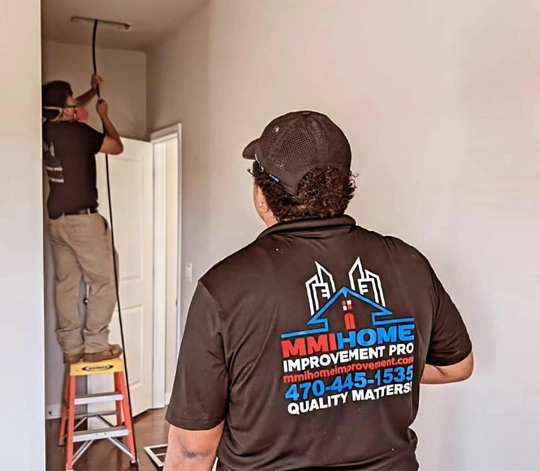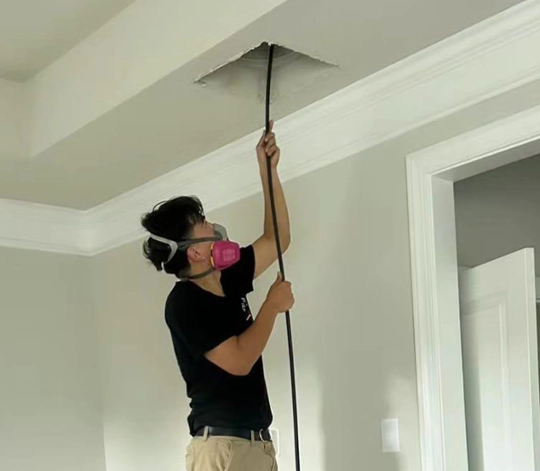It’s important to keep the air inside your home or office clean since we spend most of our time indoors. Indoor air quality (IAQ) affects our health, comfort, and productivity.Also, One of the best ways to make sure your air is clean and safe is by doing an Indoor Air Quality Test. This blog post will explore what an indoor air quality test involves, why it’s important, and how it can benefit your living or working space.Also If you are in Georgia, look no further than MMI Home Improvement Pro for Indoor Air Quality Testing in Georgia.


What is Indoor Air Quality Testing?
Indoor Air Quality Testing checks the air in your home or office for pollutants and other factors affecting your health and comfort. This thorough checking helps to find dirt particles and sources of pollution that might be present in your air.
During the test, air samples are taken from different areas and analyzed for pollutants like dust, mold, and chemicals. The test also measures humidity, moisture, temperature, and how well your space is ventilated. By identifying these factors, the test helps find issues like poor ventilation, excess moisture, or harmful chemicals. fixing these problems can improve air quality, create a more comfortable space, and create a healthier indoor environment. Also, Regular testing makes sure your home or office remains safe and pleasant.
Key Parts of an Indoor Air Quality Test
Air Sampling and Analysis
Collecting air samples is a key part of the Indoor Air Quality Test. These samples are checked for:
- Particulate Matter (PM2.5 and PM10): Tiny particles that can enter your lungs and bloodstream, often found in dust and smoke.
- Volatile Organic Compounds (VOCs): Chemicals from paints, cleaning products, and other materials. Also, high levels can cause health problems.
- Carbon Dioxide (CO2): High levels can be a sign of poor ventilation and may affect your comfort and thinking.
- Carbon Monoxide (CO): A colorless, odorless gas that can be very harmful at high levels.
- Formaldehyde: A common indoor pollutant found in many building materials.

Humidity and Moisture Levels
Humidity affects indoor air quality. Too much moisture can lead to mold, while too little can cause dryness. The test checks:
- Relative Humidity: Ideally, it should be between 30-50% to prevent mold and other issues.
- Moisture Detection: Finds sources of excess moisture, like leaks, which can cause mold growth.
Temperature Measurement
Temperature affects comfort and can influence some pollutants. The test checks:
- Indoor Temperature: Should be within a comfortable range (68-72°F or 20-22°C) to control humidity and comfort.
Ventilation Assessment
Good ventilation is important for air quality. The test will evaluate:
- Air Exchange Rates: Measures how often indoor air is replaced with outdoor air, reducing pollutants.
- Ventilation Systems: Check how well your HVAC system brings fresh air and removes stale air.
Detection of Biological Contaminants
Mold, bacteria, and viruses can affect health. The test includes:
- Mold Spore Count: Measures mold spores in the air, which can cause breathing problems.
- Bacteria and Virus Testing: Finds harmful microorganisms in the air.
Assessment of Chemical Pollutants
Besides VOCs and formaldehyde, the test may also check for:
- Radon Levels: A radioactive gas that can build up indoors, increasing cancer risk.
- Asbestos Fibers: Checked in older buildings to make sure there’s no risk from asbestos.
Why Indoor Air Quality Testing is Important
Indoor Air Quality Testing is essential for a healthy and comfortable indoor environment.However, Poor air quality can affect your health, comfort, and HVAC system’s efficiency.
Health Benefits
- Reduces Health Risks: Identifies and fixes dirt particles like dust, VOCs, and mold, which can cause allergies, asthma, and other health problems.
- Improves Well-being: Better air quality reduces symptoms of respiratory conditions and lowers the risk of chronic diseases.
Enhanced Comfort
- Optimizes Indoor Environment: Balances temperature, moist level and ventilation for a more comfortable space.
- Supports Productivity: A pleasant indoor environment can improve comfort, sleep, and daily activities.
Energy Efficiency
- Improves HVAC Performance: Finds ventilation issues that can affect energy use.
- Reduces Energy Bills: Better HVAC performance can lower energy costs.
Compliance and Safety
- Ensures Regulatory Compliance: Helps meet workplace health and safety standards, avoiding legal issues.
- Maintains Workplace Health: Make sure a safe environment, protecting employee health.
Early Detection of Problems
- Prevents Major Issues: Checks air quality or HVAC problems early, allowing for timely fixes.
- Avoids Costly Repairs: Fixes issues before they become more harmful, and saves on expensive repairs, and avoids health problems.
For more details, read Benefits of Air Duct Cleaning for Improved Indoor Air Quality.
How to Proceed with Indoor Air Quality Testing
Hire a Professional
It’s best to hire a certified indoor air quality expert for good results. They have the skills and tools to thoroughly check and provide valuable suggestions.
Review Results
After the test, discuss the results with the professional. So, They’ll explain any findings and suggest steps to fix any problems.
Implement Solutions
Based on the results, you may need to improve ventilation, reduce pollutants, or use air purifiers.

Summary
An Indoor Air Quality Test is important for keeping your indoor environment healthy and comfortable. However,by understanding what the test includes and why it’s important, you can ensure the air you breathe is clean and safe. Regular IAQ testing can help keep your home or office healthy, efficient, and comfortable.Also. For more information, consider consulting with professionals who can guide you through the testing process and help you implement effective solutions.
